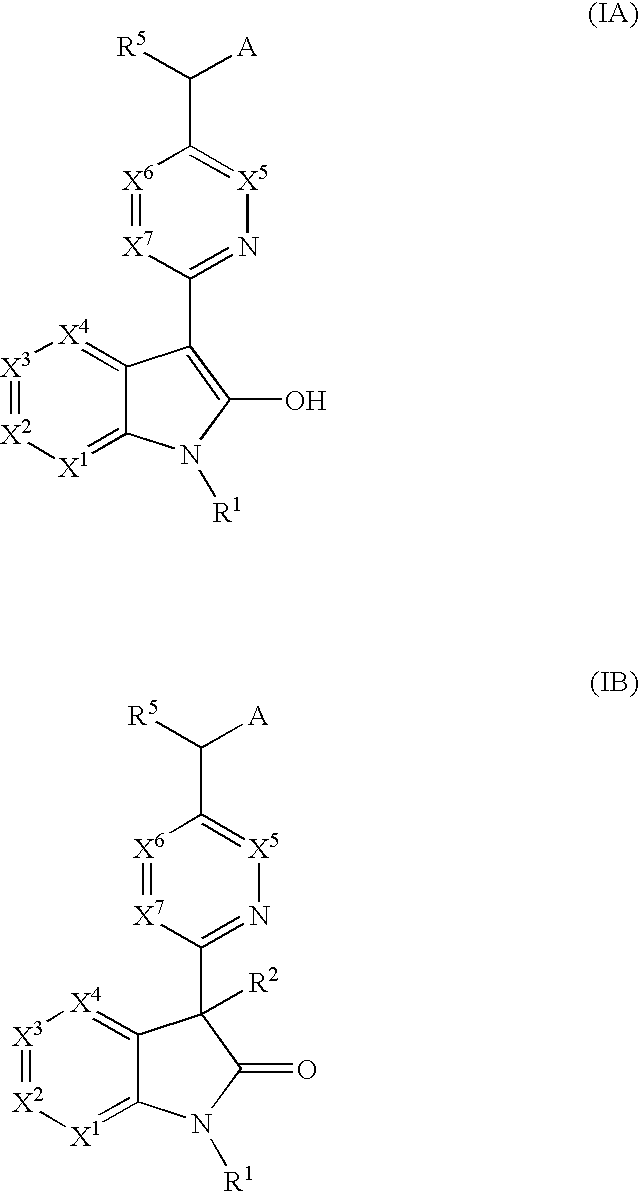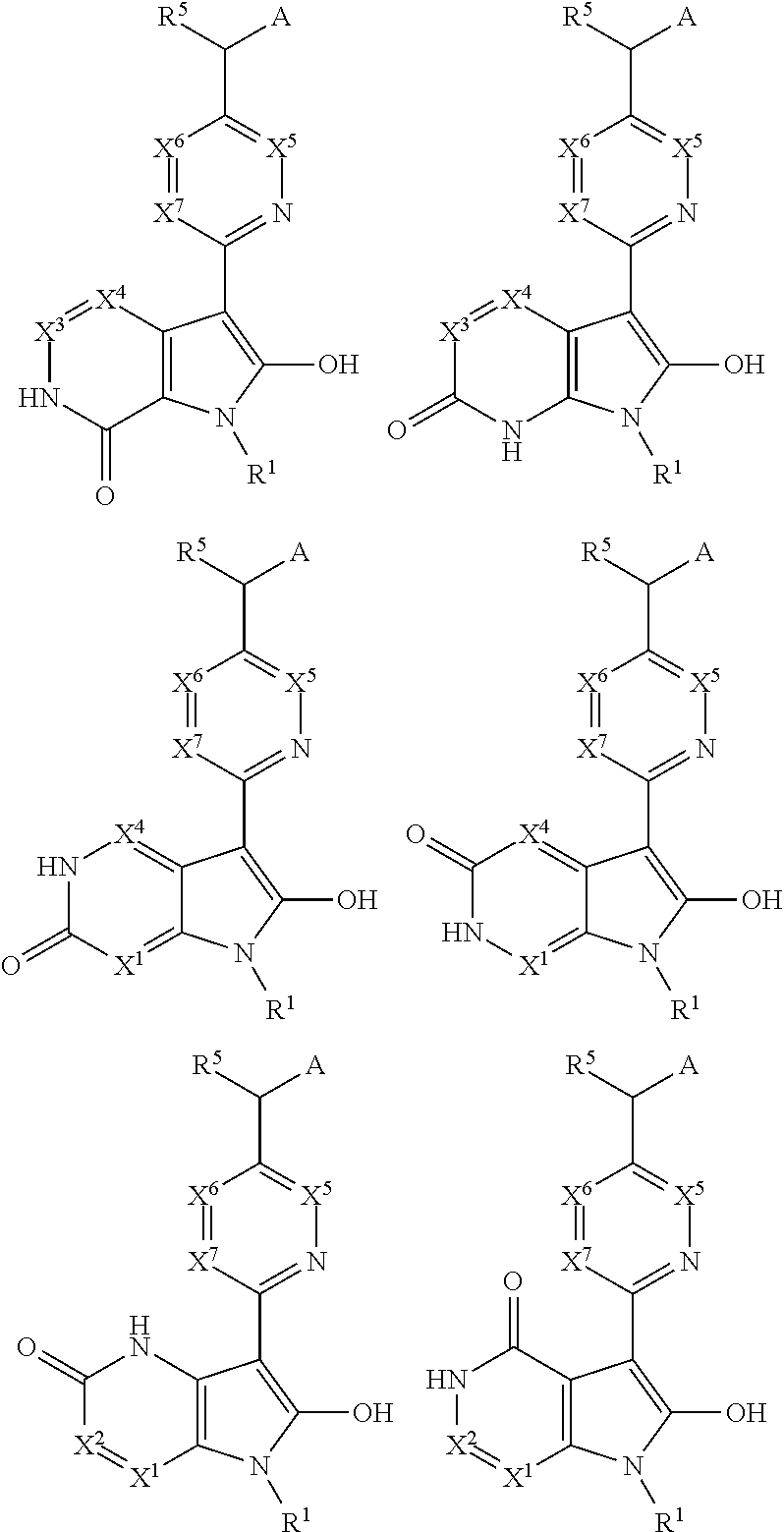Heterocyclic compounds and their use as glycogen synthase kinase-3 inhibitors
a glycogen synthase and glycogen technology, applied in the field of heterocyclic compounds, can solve the problems of neurotrophic activity, inability of pharmacological gsk-3 inhibitors to selectively inhibit one of the isoforms, etc., and achieve the effect of prevention and/or treatmen
- Summary
- Abstract
- Description
- Claims
- Application Information
AI Technical Summary
Benefits of technology
Problems solved by technology
Method used
Image
Examples
examples
[0407]The compounds were either characterized via proton-NMR in d6-dimethylsulfoxide or d-chloroform on a 400 MHz or 500 MHz NMR instrument (Bruker AVANCE), or by mass spectrometry, generally recorded via HPLC-MS in a fast gradient on C18-material (electrospray-ionisation (ESI) mode), or melting point.
[0408]The magnetic nuclear resonance spectral properties (NMR) refer to the chemical shifts (δ) expressed in parts per million (ppm). The relative area of the shifts in the 1H-NMR spectrum corresponds to the number of hydrogen atoms for a particular functional type in the molecule. The nature of the shift, as regards multiplicity, is indicated as singlet (s), broad singlet (s, br.), doublet (d), broad doublet (d br.), triplet (t), broad triplet (t br.), quartet (q), quintet (quint.) and multiplet (m).
Abbreviations:
[0409]
DMSOdimethylsulfoxideDCM dichloromethaneDMFdimethylformamideMeOHmethanolTMSItrimethylsilyliodideTFA trifluoroacetateTLC thin layer chromatographyRTroom temperatureddays...
preparation examples
I. Preparation Examples
Example 1
3-(5-((Dihydro-1H-furo[3,4-c]pyrrol-5(3H,6H,6aH)-yl)methyl)pyridin-2-yl)-2-hydroxy-1H-indole-5-carbonitrile
[0410]
1.1 6-Chloro-N-methoxy-N-methylnicotinamide
[0411]A suspension of 2.3 g (12.81 mmol) of 6-chloronicotinoyl chloride and 1.53 g (15.37 mmol) of N,O-dimethylhydroxylamine in 46 mL of dichloromethane was cooled to 0° C. After dropwise addition of 5.36 mL (38.4 mmol) of triethylamine the resulting reaction mixture was warmed to RT and stirred for further 16 h. The mixture was subsequently washed with water (40 mL), 5% citric acid (40 mL), water (40 mL), and brine (40 mL). The organic layer was dried with Na2SO4, filtered, and the solvent was evaporated at reduced pressure yielding the titled compound as an oil. Amount 2.30 g. Yield 89%.
[0412]1H-NMR (CDCl3, 400 MHz) δ 3.42 (s, 3H), 3.59 (s, 3H), 7.41 (dd, 1H), 8.04 (dd, 1H), 8.79 (d, 1H)
[0413]MS (ES-API) m / z 201.0 (M+H+, 100%).
1.2 6-(5-Cyano-2-hydroxy-1H-indol-3-yl)-N-methoxy-N-methylnicotin-amid...
example 2
3-(5-(Morpholinomethyl)-pyridin-2-yl)-1H-pyrrolo[2,3-b]pyridin-2-ol
[0422]
2.1 2-Chloro-5-(chloromethyl)-pyridine 1-oxide
[0423]To an icecold solution of 2-chloro-5-(chloromethyl)-pyridine (5 g, 29.6 mmol) in DCM (130 mL) was added dropwise a solution of 3-chlorobenzo-peroxoic acid (10.23 g, 59.3 mmol) in DCM (80 mL). The resulting solution was warmed to RT and stirred for 7 d till all starting material was consumed as judged by TLC. After this the reaction mixture was carefully treated with a saturated K2CO3 solution. The resulting precipitate was removed by filtration and the organic layer was washed with a saturated K2CO3 solution and brine. The organic layer was dried, filtered, and evaporated yielding the titled compound as an oil which slowly crystallizes (5.3 g, 90% yield).
[0424]1H-NMR (CDCl3, 400 MHz) δ 4.52 (s, 2H), 7.26 (dd, 1H), 7.52 (d, 11-1), 8.42 (d, 1H)
[0425]MS (ES-API Pos) m / z 178.0 (M+H+, 100%).
2.2 2-Chloro-5-(morpholinomethyl)-pyridine 1-oxide
[0426]A mixture of 1.5 g ...
PUM
| Property | Measurement | Unit |
|---|---|---|
| molecular weights | aaaaa | aaaaa |
| molecular weights | aaaaa | aaaaa |
| temperature | aaaaa | aaaaa |
Abstract
Description
Claims
Application Information
 Login to View More
Login to View More - R&D
- Intellectual Property
- Life Sciences
- Materials
- Tech Scout
- Unparalleled Data Quality
- Higher Quality Content
- 60% Fewer Hallucinations
Browse by: Latest US Patents, China's latest patents, Technical Efficacy Thesaurus, Application Domain, Technology Topic, Popular Technical Reports.
© 2025 PatSnap. All rights reserved.Legal|Privacy policy|Modern Slavery Act Transparency Statement|Sitemap|About US| Contact US: help@patsnap.com



